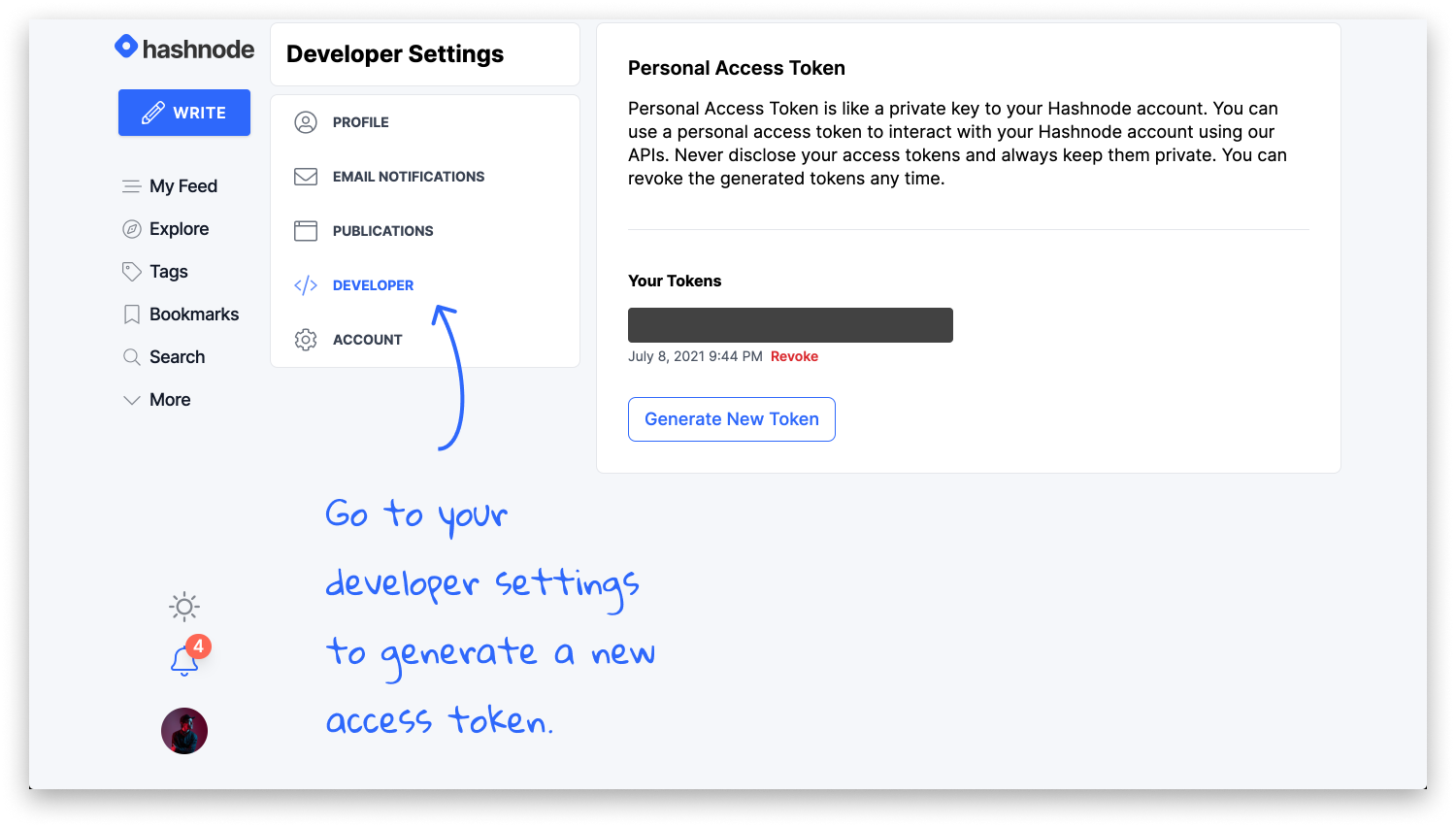
Post to Dev, Hashnode, and Medium using their APIs
The goal of this article is to help you connect to each of these site's APIs in order to programmatically post, update, and enjoy with these services.
Writing a single markdown file for my personal blog and copy and pasting it into these other blogging platforms isn't too challenging... until I need to edit something. A simple type change requires me to load four different sites, navigating through their wildly different UI, in order to make simple changes.
This gets old fast.
We're developers. It's much more fun and beneficial to automate these repetitive tasks.
Medium API
Documentation - https://github.com/Medium/medium-api-docs
Getting the authentication token
- Login to Medium
- Navigate to Integration tokens
- Enter description for your token and click the get integration token button
 |
| Medium's integration token panel |
This will generate a token that will be included within requests to Medium's API.
Getting the authenticated user’s details
Medium provides the endpoint GET https://api.medium.com/v1/me to get the authenticated user data.
Here's an example request using NodeJS:
fetch('https://api.medium.com/v1/me', {
method: 'GET',
headers: {
'Content-Type': 'application/json',
Authorization: 'Bearer <AUTHENTICATION TOKEN HERE>',
},
})
.then(res => res.json())
.then(res => console.log(JSON.stringify(res)))
Within the data returned from this endpoint is an id. You will want to save this ID value because it will be required to create a Medium article using NodeJS.
Programmatically creating a Medium article
Now that we have the authentication token and ID, we can use the endpoint POST https://api.medium.com/v1/users/{{authorId}}/posts. The documentation posted above goes into detail on what parameters are required and/or available.
This endpoint accepts either markdown or HTML. You need to explicitly set the contentFormat field to either markdown or html.
Here's an example of a request using NodeJS:
fetch('https://api.medium.com/v1/users/<USER-ID>/posts', {
method: 'POST',
headers: {
'Content-Type': 'application/json',
Authorization: 'Bearer <REPLACE WITH TOKEN GENERATED ABOVE>',
},
body: JSON.stringify({
title: 'Liverpool FC',
contentFormat: 'markdown',
content: '# You can put Markdown here.\n***\nSee what it looks like?',
canonicalUrl: 'http://jamietalbot.com/posts/liverpool-fc',
tags: ['football', 'sport', 'Liverpool'],
publishStatus: 'public',
}),
})
.then(res => res.json())
.then(res => console.log(JSON.stringify(res)))
If this returned a 201 status code, you should now be able to see your post on Medium.com
Available Endpoints:
Here's a list of the available endpoints:
Getting the authenticated user’s details:
GET https://api.medium.com/v1/me
Listing the user’s publications:
GET https://api.medium.com/v1/users/{{userId}}/publications
Fetching contributors for a publication:
GET https://api.medium.com/v1/publications/{{publicationId}}/contributors
Creating a post:
POST https://api.medium.com/v1/users/{{authorId}}/posts
Creating a post under a publication:
POST https://api.medium.com/v1/publications/{{publicationId}}/posts
Uploading an image:
POST https://api.medium.com/v1/images
Unfortunately, Medium's public API is fairly limited. We can create and get posts, but the ability to programmatically edit them is not there yet. I hope this eventually changes, giving the programmer better tools to work with them,
dev.to API
Documentation - https://docs.forem.com/api/
Getting the authentication token
This will require a dev.to account. Navigate to their docs and follow the instructions to get the authentication token.
Creating an dev.to article using their API
Their documentation is far more extensive than Medium's public API. Their docs for this endpoint are here. If you click the article dropdown arrow, you can see all of the parameters that they accept. You can
Example request using NodeJS:
fetch('https://dev.to/api/articles', {
method: 'POST',
headers: {
'Content-Type': 'application/json',
'api-key': '<AUTHENTICATION TOKEN HERE>',
},
body: JSON.stringify({
article: {
title: 'Hello, World!',
published: true,
content: '# You can put Markdown here.\n***\n',
tags: ['discuss', 'help'],
series: 'Hello series',
},
}),
})
.then(res => res.json())
.then(res => console.log(JSON.stringify(res)))
Hashnode API
Documentation - https://api.hashnode.com/
Hashnode's API is a GraphQL API unlike the REST APIs we worked with in Medium and dev.to.
They have a few blogposts within their blog discussing their public API, but they were posted in 2019 so a handful of things discussed within the articles have been deprecated such as the GLOBAL and FOR_ME FeedType's. Give them a read if you want to understand things a bit better, but keep in mind that a lot of the parameters have been deprecated.
Getting the authentication token
You can create/revoke them from Hashnode settings. Login to your account, go to the developer settings, and generate a new token.
 |
| Generate Hashnode Auth Token |
Documentation
I've found the source of truth to be within their GraphQL Playground. You'll need to click around their playground to see what endpoints are available as well as the expected inputs.
 |
| Hashnode's GraphQL Api Playground |
 |
| Hashnode Documentation Navigation |
Example request using NodeJS:
fetch('https://api.hashnode.com', {
method: 'POST',
headers: {
'Content-Type': 'application/json',
Authorization: '<AUTHENTICATION TOKEN HERE>',
},
body: JSON.stringify({
query:
'mutation createStory($input: CreateStoryInput!){ createStory(input: $input){ code success message } }',
variables: {
input: {
title: 'What are the e2e testing libraries you use ?',
contentMarkdown: '# You can put Markdown here.\n***\n',
tags: [
{
_id: '56744723958ef13879b9549b',
slug: 'testing',
name: 'Testing',
},
],
coverImageURL:
'https://codybontecou.com/images/header-meta-component.png',
},
},
}),
})
.then(res => res.json())
.then(res => console.log(JSON.stringify(res)))
Conclusion
Now that we can programmatically post to these three sites, we can build out an application that allows dynamic inputs, such as a file reader to pass a .md file to the requests content and contentMarkdown parameters, editing posts, and many other things. We
Keep an eye out. I plan on spending some time building out an interface for Dev Bloggers to be able to do just that. It's not fun manually editing the same text in each post across four different sites. I hope to solve that problem.
Good luck!
Let me know what you think of this article through Twitter @codybontecou